17+ Sample Backpacking Checklists
-
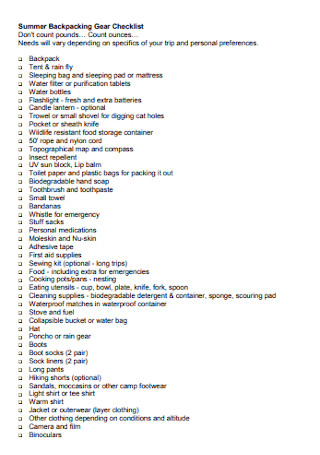
Summer Backpacking Gear Checklist
download now -
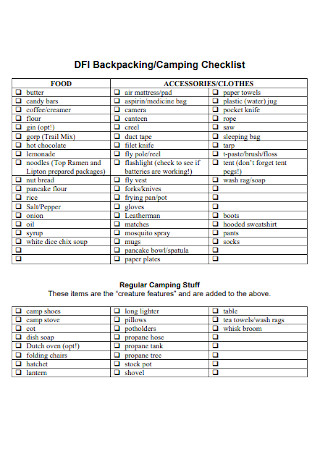
Backpacking Camping Checklist
download now -
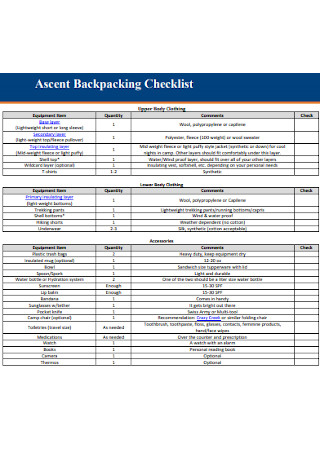
Ascent Backpacking Checklist
download now -
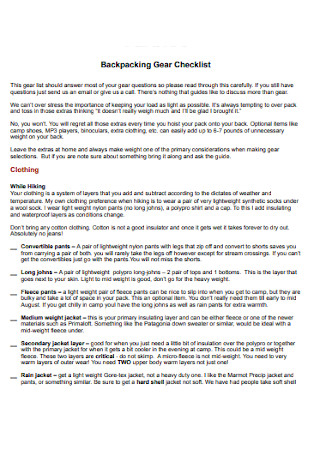
Backpacking Gear Checklist
download now -
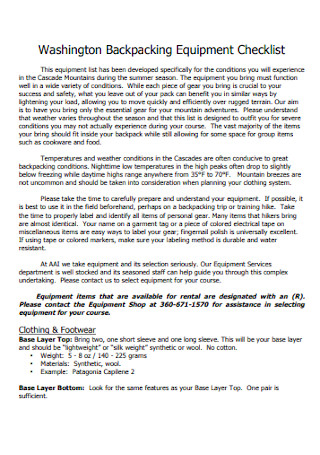
Backpacking Equipment Checklist
download now -
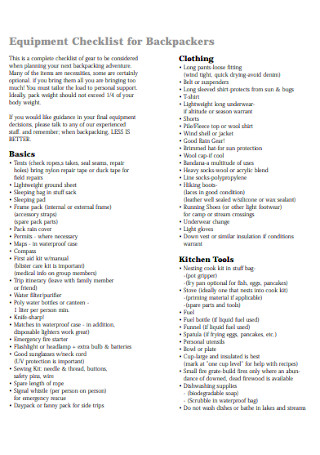
Equipment Checklist for Backpackers
download now -
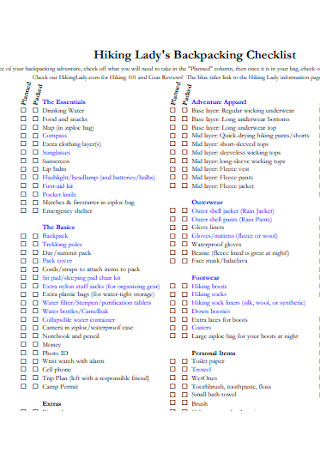
Lady Backpacking Checklist
download now -
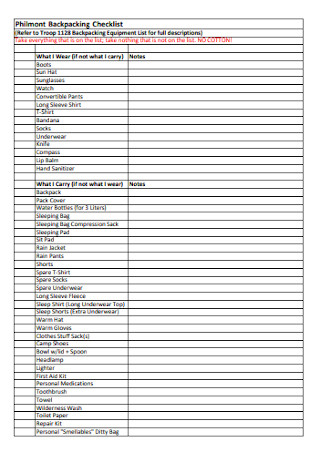
Philmont Backpacking Checklist
download now -
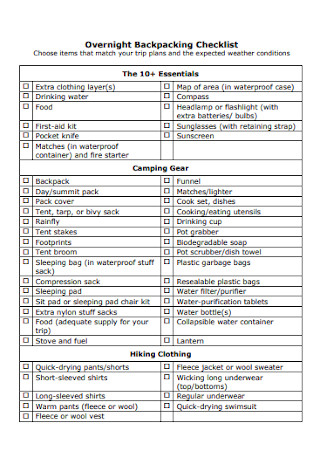
Overnight Backpacking Checklist
download now -
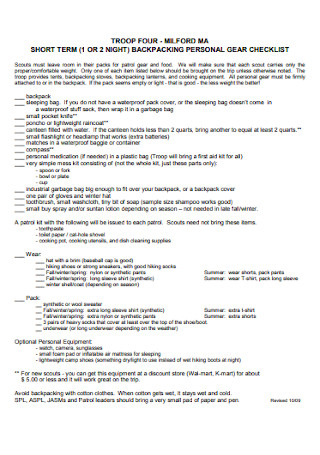
Backpacking Personal Gear Checklist
download now -
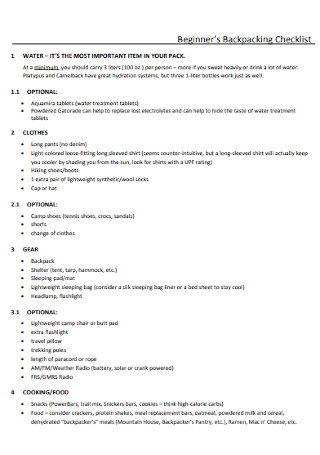
Beginners Backpacking Checklist
download now -
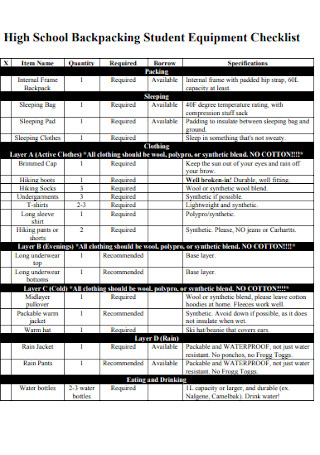
School Backpacking Student Equipment Checklist
download now -
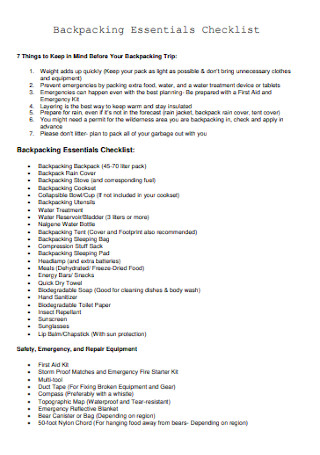
Backpacking Essentials Checklist
download now -

Essential Backpacking Checklist
download now -
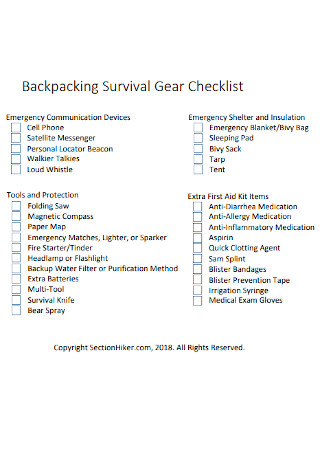
Backpacking Survival Gear Checklist
download now -
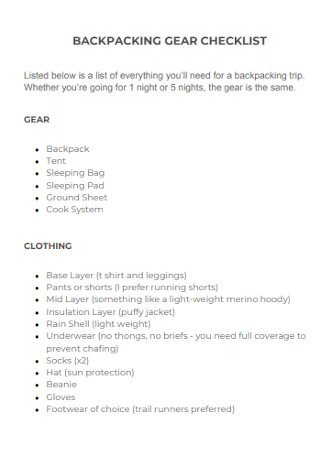
Backpacking Gear Checklist Template
download now -
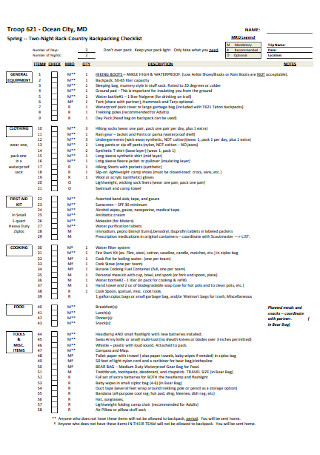
Country Backpacking Checklist
download now -
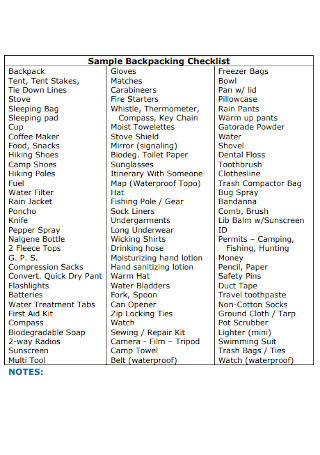
Sample Backpacking Checklist Template
download now
FREE Backpacking Checklist s to Download
17+ Sample Backpacking Checklists
What Is a Backpacking Checklist?
Components of a Backpacking Checklist
How to Plan a Backpacking Trip
FAQs
Is it okay to use an ordinary backpack for a backpacking trip?
What are the ideal shoes to wear during a backpacking trip?
How do you plan on a backpacking menu?
Individuals who enjoy adventures in the great outdoors enjoy the usual activities involving trekking, mountain biking, climbing, and backpacking, either alone or as part of a group. Adventurous people tend to turn to backpack ventures as it allows persons to move around without difficulty. For beginners, it is advisable to have a backpacking checklist to start the road to adventure. Learn about backpacking checklists in the article below, with information about their description, components, and construction, along with frequently asked questions.
What Is a Backpacking Checklist?
A backpacking checklist is a list of items that an individual completes for their trip or activity. These simple checklists serve as a reminder for individuals who plan on going on a hiking trip. It is also helpful for persons who merely want to explore an area or country without booking stays in fancy hotels or lodgings. Backpacking in itself is a low-cost alternative and activity for individuals who independently travel while carrying essential items in a backpack. Usually, these people move around for longer durations than a typical vacation. The goal is to have only the necessary objects to carry around in a backpack while thoroughly enjoying the ambiance or a particular place. The usual people enjoying this lifestyle are those who enjoy meeting new personalities while exploring the great outdoors.
According to the gathered data by David Lange published under Statista in February 2021, the number of people participating in backpacking activities in the United States in 2019 reached approximately 10.66 million people. From 2006-2019, the number of participants fluctuates, and significant spikes of activity in the years 2008, 2012, 2014, and 2017. Numbers continue to stay stagnant, entering 2015 onwards, as people continue to participate in backpacking.
Components of a Backpacking Checklist
Backpacking checklists generally contain items essential to individuals who plan for a trip, specifically for outdoor activities. These items must be habitually inside a person’s backpack to as it comes in handy for survival. The checklist items intend to help individuals prepare themselves in cases of emergency, especially in outdoor environments. Here are the essential items found in a backpacking checklist for any person.
How to Plan a Backpacking Trip
Whether a person is a beginner or an experienced backpacker, it is necessary to plan for the trip. Many questions arise when it comes to outdoor trips and adventures, why, how, and when. Having a step-by-step guide helps in becoming organized and confident to set out on an adventure. Follow these steps into planning the next trip and plan from start to finish without forgetting the necessary details.
Step 1: Select a Date and Location of the Trip
Selecting a date and location for a trip schedule is the first step on any occasion. The dates dictate if the place is viable to visit and if it is necessary to stay for a longer or shorter period. For first-time backpacking individuals, it is helpful to stay for short periods, preferably one to two nights stay. However, if a person is experienced and has enough time on hand, take the time to decompress and reap the benefits of being in the wilderness. Picking a trail is essential to aligning the length and difficulty to the individual’s experience. A person new to the activity ideally covers a distance of five to seven miles a day. Carrying a backpack appears as a challenge as well if the individual is not used to it. Research a trail compatible with physical endurance and capacity and start from there.
Step 2: Keep Updates on Weather Forecasts
Always check the weather for about two days before continuing to the location. Checking the weather ahead of time, an individual saves time, helps adjust the trip date, and prepares necessary tools and clothing accordingly. If the weather is manageable, ensure all equipment is neatly packed, and if not, refrain from pursuing the plan further and reschedule.
Step 3: Check Permit Requirements and Transportation
Before going to the trail, check if the location requires a permit. Many of the tracks, especially national parks, require wilderness permits obtained by individuals several months in advance before the set date. Popular backpacking traits in America, including Yosemite Park and the Grand Canyon, require these permit four to five months in advance. Depending on the location of the trail, there are other requirements and prohibitions aside from the permit. It is necessary to research thoroughly about these mandatory conditions. Also, ensure there is a way to get to and from the trail. Depending on the location, there are open areas designated for parking. If traveling in a group, it is ideal to travel using a shuttle or ask a friend or family member to drop off. Some hotels also offer free shuttle services to famous hiking locations nearby.
Step 4: Get Necessary Gear and Test Equipment
Do not be intimidated by expensive tools and gear if it means the individual’s safety. Another alternative is to ask friends or family members who engage in the same activity to lend their equipment. Ensure that the items sufficiently fit in the backpack before setting out. Guarantee the tools are not too heavy that it affects the entire trip by making it difficult and uncomfortable for the individual. Also, it is necessary to know what the pieces of equipment are and how it used. It is pointless to bring items that will not serve their intended purpose because of the lack of knowledge to operate them. The point of testing out the gear beforehand is to ensure none of it is faulty.
Step 5: Stock on Food and Identify Water Sources
Planning food is an essential part of a backpacking trip. The goal is to eat well while bringing lightweight food with long shelf life. Ensure to check the food storage requirements of the trail location to ensure nothing gets to the packed food. The water supply an individual brings is finite, and it is one of the essential items to bring on the trip. It is advisable to carry a map and locate water reserves and other water sources along the trail to help with the water supply. It is also advisable to have filtering devices during a hiking trip to ensure the water consumed is safe and clean.
FAQs
Is it okay to use an ordinary backpack for a backpacking trip?
It is, although not advisable. Most professionals, however, would make use of backpacks made for the activity. Choose a pack with an internal frame that is fit to contour the body, padded shoulder and waist straps, with front, side, and bottom loading options. A bonus if it has a place for a water bladder. Most of these backpacks have a waterproof design or come with a rain cover to protect clothes and other items from getting wet in inclement weather. If the plan is for a beginner backpacking trip, a 35-liter backpack will prove to be sufficient. However, 40 to 55 liters provide enough space and are best suited for any trip. If there is no one to lend or borrow from, the individual must ask a sales representative or customer support to help find a suitable backpack.
What are the ideal shoes to wear during a backpacking trip?
A consensus is that hiking shoes are the single most valuable thing that an individual needs to wear, and the priority is that they are for comfort and durability. Tennis shoes don’t provide much traction. Borrowing hiking boots that are too small or too big give blisters or leaves the individual uncomfortable for the rest of the trip. However, it all boils down to how comfortable and durable the shoes a person currently wears and their trail destination. The best way to test out if the shoes are enduring is to grab a backpacking pack, put a few heavy objects inside to simulate the weight, and go for a walk on a treadmill or around the neighborhood.
How do you plan on a backpacking menu?
For a first backpacking meal, the best options are prepackaged, dehydrated, and healthy meals. This prepacked food, despite its appearance, is made specifically to be lightweight, compact, protein-filled, and easy to cook. The directions consist of pouring hot water into the package, let it sit for a few minutes, and eat. There are a variety of choices from breakfast, lunch, dinner, and even dessert. Additionally, protein bars and mixed nuts are convenient and healthy snack foods for a trip, so remember to pack them along.
Engaging in any trip is exciting, whether it is the first time to visit a specific destination or a frequent vacation. It is gratifying to witness and experience activities out of an individual’s comfort zone, thoroughly seeing them enjoy themselves. Plenty of people try new and different activities to expand their horizons, mostly on their own or through the help of friends and family. It is never too late or too early to start a hobby, especially if it means a sense of freedom and calmness. In the words of Paulo Coehlo, “Travel is never a matter of money but of courage.”. It is courageous of people to pursue travel and balance everything in their lives. Start an exciting adventure now and start with the backpacking checklist samples for use and download above.
